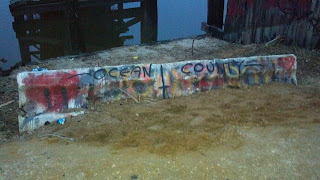As a quick update:
- A report of a king eider hen near a jetty in Cape May Point delivered a common eider for us. (That beach spot also yielded the rare bare-rumped jaybird, but that's another story.)
- A very yellow western tanager revealed himself after a very brief wait on a busy street corner in Cape May Court House.
- And... after what would have been deemed a wild goose chase in other circumstances, we caught a glimpse of a crested caracara (you might remember how rare these are in New Jersey, after our story of seeing one in West Windsor last year.)
A confession: whenever Ivan mentions owling, I do a mental eyeroll, especially in pine forests where they might be tucked in broad daylight. Don't get me wrong. I love owls. In fact, our first joint birding experience was a January visit to Wallkill WMA to visit the short-eared owls. He got one in the viewing scope within a few minutes, and it accommodatingly turned to face us just as I was getting my look. Since then, it's been a lot harder to tease them out, but in Ivan's defense, owls of any ilk do their best not to be seen. Finding them takes a certain amount of luck, regardless of how advanced your birding skills are.
This time around, when I started my usual jovial owl rant, Ivan simply said, "You'll like this place. It's the road to nowhere." Say no more. Let's check it out.
We got to Route 72 as twilight was descending. A few turns brought us away from the state highway hubbub and into marsh territory. One more right turn and we were on Stafford Avenue, a lightly-traveled road occasionally marked with a pothole. "This is better than I remembered it," Ivan told me, explaining that the road is rarely maintained and can get heavily rutted and uneven a mile or so in, when it turns to hard-packed sand and dirt.
The road goes first through a forest, adding a little spookiness to the trip, but then the horizon widens to accommodate marshgrass, with no trees to obstruct the view for acres. Harriers ordinarily would have been scouting for their last meals of the day, but we saw nothing in flight. Still, the terrain was incredibly cool, as was the feeling that absolutely nobody was within shouting distance. The only real sign of human progress was the utility poles on the side of the road, though four or five of them were tilted dangerously enough to take the whole system down into the brackish water with a good gust.
 |
| The bridge to nowhere. |
 "Behold!" Ivan exclaimed as he stepped out of the car. "Nowhere!" He had that right. Marsh stretched out almost as far as the eye could see, and it was so quiet, well, so quiet that any of the usual analogies about quiet were useless. That, my friends, is Manahawkin Wildlife Management Area at dusk in January.
"Behold!" Ivan exclaimed as he stepped out of the car. "Nowhere!" He had that right. Marsh stretched out almost as far as the eye could see, and it was so quiet, well, so quiet that any of the usual analogies about quiet were useless. That, my friends, is Manahawkin Wildlife Management Area at dusk in January. How was I not aware of this place? I pride myself on knowing these spots, and from what I can recall, our better-known friends who cover the odder parts of the state haven't featured this Road to Nowhere. It seems that perhaps it's a secret kept by sportsmen (the state DEP maps list the area as the Manahawkin Hunting and Fishing Grounds) and birders, with the occasional spray paint-wielding local teen for good measure. I could see where the hunters and fishing enthusiasts would value the area; the marsh was sparsely crossed by old mosquito-control channels they could use to get to a blind or favorite spot.
How was I not aware of this place? I pride myself on knowing these spots, and from what I can recall, our better-known friends who cover the odder parts of the state haven't featured this Road to Nowhere. It seems that perhaps it's a secret kept by sportsmen (the state DEP maps list the area as the Manahawkin Hunting and Fishing Grounds) and birders, with the occasional spray paint-wielding local teen for good measure. I could see where the hunters and fishing enthusiasts would value the area; the marsh was sparsely crossed by old mosquito-control channels they could use to get to a blind or favorite spot.  Gazing across the marsh from one of its few (maybe only) high spots, I was again reminded of the Meadowlands -- the rickety old abandoned bridges you can see as your train rumbles along to Newark or New York, the ditches dug in the futile hopes of keeping the skeeters at bay, the wisdom of letting a certain amount of marsh just be and be natural.
Gazing across the marsh from one of its few (maybe only) high spots, I was again reminded of the Meadowlands -- the rickety old abandoned bridges you can see as your train rumbles along to Newark or New York, the ditches dug in the futile hopes of keeping the skeeters at bay, the wisdom of letting a certain amount of marsh just be and be natural.As for the owls, well, they were keeping to themselves during our visit. We saw none at all before daylight finally surrendered to darkness, though Ivan thought he might have heard a short-ear bark in the distance (some say they sound like terriers). Perhaps next time.
No comments:
Post a Comment
Note: Only a member of this blog may post a comment.